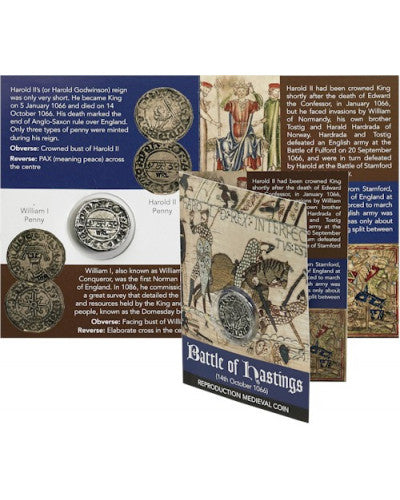
Harold II Penny Coin Pack
Regular price
£2.99
Sale
Product Description: This reproduction Harold II Penny is moulded directly from an original coin and is made from lead-free pewter. The wallet type packaging has a hole on the front in which the coin is held in a clear blister. The coin pack has an image from the Bayeux Tapestry on the front, the two coins in the collection inside, as well as additional medieval images. It has historical information about the coins and about Harold II, the Battle of Hastings and William I.
Information: Harold II's reign was very short. He became King on 5 January 1066 and died on 14 October 1066. Only three types of penny were minted during his reign. The obverse of this coin depicts the bust of Harold II and the reverse PAX across the centre.
Harold II had been crowned King shortly after the death of Edward the Confessor, in January 1066, but he faced invasions by William of Normandy, his own brother Tostig and Harold Hardrada of Norway. Hardrada and Tostig defeated an English army at the Battle of Fulford on 20 September 1066, and were in turn defeated by Harold at the Battle of Stamford Bridge five days later.
While Harold and his army were recovering from Stamford, William landed his invasion forces in the south of England at Pevensey on 28 September 1066. Harold was forced to march south, gathering forces as he went. The English army was composed of infantry and a few archers whereas only about half of the Normans were infantry, the rest being split between cavalry and archers.
The Battle of Hastings was fought on 14 October 1066. It took place 7 miles northwest of Hastings and lasted from 9am to dusk. Early efforts of the invaders to break the English battle lines had little effect. The Normans then adopted the tactic of pretending to retreat and as the English troops pursued then their cavalry attacked. This weakened Harold’s army. Later in the day Harold was killed and the battle was over.
William was crowned King on Christmas Day 1066 at Westminster Abbey. He died from injuries after falling from his horse on 9 September 1087.
Item by Westair Reproductions
